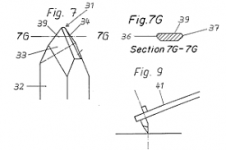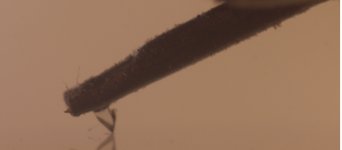I have discovered why my cartridge SRA seems so low. I didn't check the VTA for the donor stylus assembly, which was 24° vs 20°. There is a 1g difference in VTF between donor and recipient, so a mk1 eyeball 3° out on SRA seems totally believable. I hadn't spotted that Ortofon had standardised on a lower VTA than most (but not as low as Shure who were 15° IIRC).
So in one respect my frankencart is sub-optimal. But the pudding eats well 🙂
So in one respect my frankencart is sub-optimal. But the pudding eats well 🙂
I found another good explanation of SRA:
Phono CARTRIDGE Mounting, TONEARM Alignment TOOL, TURNTABLE Set-Up, Calibration, VTA, BIAS Compensation ADJUSTMENT.
Phono CARTRIDGE Mounting, TONEARM Alignment TOOL, TURNTABLE Set-Up, Calibration, VTA, BIAS Compensation ADJUSTMENT.
Agreed, different standards for cutting angle (VMA/VTA) over time is evident but SRA was not an issue until line contact stylii appeared. I would say again, it is mostly an issue of the manufacturing precision. At nominal VTF, the SRA should be around 92° (or between 90-95°).
IME, and from reports, a fine radius stylus is typically far more sensitive to SRA than wider radius types, no matter what the exact shape. But, lets face it, each of us doesn't see that many different fine line types and most us try to make them last as long as poss!
When you think about it, this means that SRA rather than VTA is the performance issue here. Given that VTA varies so much between recordings. Personally, I reckon it's the way the stylus and groove surface interact that is what matters, and that doesn't change with recorded VTA but does with SRA: the groove surface is always nominally parallel to the platter no matter what recorded VTA.
I think ThomasA is right, each stylus on merit of how accurately the stylus is set in the shank.
LD
When you think about it, this means that SRA rather than VTA is the performance issue here. Given that VTA varies so much between recordings. Personally, I reckon it's the way the stylus and groove surface interact that is what matters, and that doesn't change with recorded VTA but does with SRA: the groove surface is always nominally parallel to the platter no matter what recorded VTA.
I think ThomasA is right, each stylus on merit of how accurately the stylus is set in the shank.
LD
Last edited:
Some of us do have a slight compulsion to collect extreme stylus profiles. It might be treatable...
🙂 The cure is worse than the disease 🙂Some of us do have a slight compulsion to collect extreme stylus profiles. It might be treatable...
LD
I'd ask the stylus vendor, surely they advise the toppers on the correct angle, and hopefully it's achievable with correct tracking weight for compliance.
I'd warrant that any stylus rebuild with a new profile requires tie wire adjustment as a minimum to achieve this.
I'd warrant that any stylus rebuild with a new profile requires tie wire adjustment as a minimum to achieve this.
Some of us do have a slight compulsion to collect extreme stylus profiles. It might be treatable...
I would be guilty of that, I have Shibata, Line Contact, Micro-Ridge, and several Ortofon Replicants. (line contact-ish)
My strain gauges are equipped with a shibata and an MR.
I guess I really, really, really need to get a USB micro-scope as Bill's stylus angle looked a lot more extreme than I had expected even if a bit off.
The replicant is possibly even more extreme than the FGS in the picture. No one who knows is telling.
Glad we could be of service.
@Kevin: Now I have the FGS I will be honest that the one profile I really want to try that I don't have is one of the Expert Stylus paratraces. This is based on one of the late Dr Weinz profiles and should be pretty good. It also has the advantage of being cheaper to retip than to buy new stylii in some cases. For example an ortofon stylus 40 is £240 and a paratrace retip is £120. And to add to the temptation, even if there is no logical reason £180 gets you a cantilever swap to boron or sapphire. The risk/reward ratio is starting to get tempting, although I have read reports that the paratrace wears more quickly, but the internet metadata has no real patterns in it.
@Kevin: Now I have the FGS I will be honest that the one profile I really want to try that I don't have is one of the Expert Stylus paratraces. This is based on one of the late Dr Weinz profiles and should be pretty good. It also has the advantage of being cheaper to retip than to buy new stylii in some cases. For example an ortofon stylus 40 is £240 and a paratrace retip is £120. And to add to the temptation, even if there is no logical reason £180 gets you a cantilever swap to boron or sapphire. The risk/reward ratio is starting to get tempting, although I have read reports that the paratrace wears more quickly, but the internet metadata has no real patterns in it.
Sigh, well I can't raise the back high enough to get the adjustment I need, so will need to shim the headshell. Rummage in the shed required, or maybe just give up and buy this Pats Audio Dual Turntable Tracking Angle Shim for TK-12 Cartridge Holder | eBay .
maybe just give up and buy this
Seems like you would also need a shim on top of the head shell, since the screws will
no longer be perpendicular to it.
The part on the interwebs is for a Dual so probably light. I need to find a dual owner to confirm this. The arm is quite light so a gram will not hurt. For trials I have some copper shim but will probably just cut up an old credit card.
Hi Guy's, Well I am trying to understand this, I have read it over many times & I still believe that billshurv shown lower his arm not make it higher. I have done a little work on his original photo, lining it up parallel & adding some 30 deg angle black lines so that it is easier to judge the angle of the stylus, the red line is what I judge to be the center on the stylus.
Unfortunately I cannot find a protractor otherwise I could measure it, perhaps someone has one who can.
To me the stylus looks more like on a 112 deg (or 86 deg depending on how you look at it.
Cheers Derek😕😀
The contact patch of this Gyger stylus does not follow the red line. See pic patent.
Attachments
The Gyger* is unusual in its design but in theory it is easier to align. Except when it steadfastly won't! I forgot to copy off the pictures of my experiments with slivers of credit card as it was late but will tonight. I need to step back and think through what is happening as I would have expected the SRA to have tipped over 90° but it hasn't.
*internet lore has it that the FGS is in fact a VdH design but I have not seen affirmative proof of that other than looks similar.
*internet lore has it that the FGS is in fact a VdH design but I have not seen affirmative proof of that other than looks similar.
The Gyger* is unusual in its design but in theory it is easier to align. Except when it steadfastly won't! I forgot to copy off the pictures of my experiments with slivers of credit card as it was late but will tonight. I need to step back and think through what is happening as I would have expected the SRA to have tipped over 90° but it hasn't.
*internet lore has it that the FGS is in fact a VdH design but I have not seen affirmative proof of that other than looks similar.
The Gyger II is the vdH-like design but the Gyger I or "S" is the slanted design.


- Status
- Not open for further replies.
- Home
- Source & Line
- Analogue Source
- SRA, why 92 degrees

